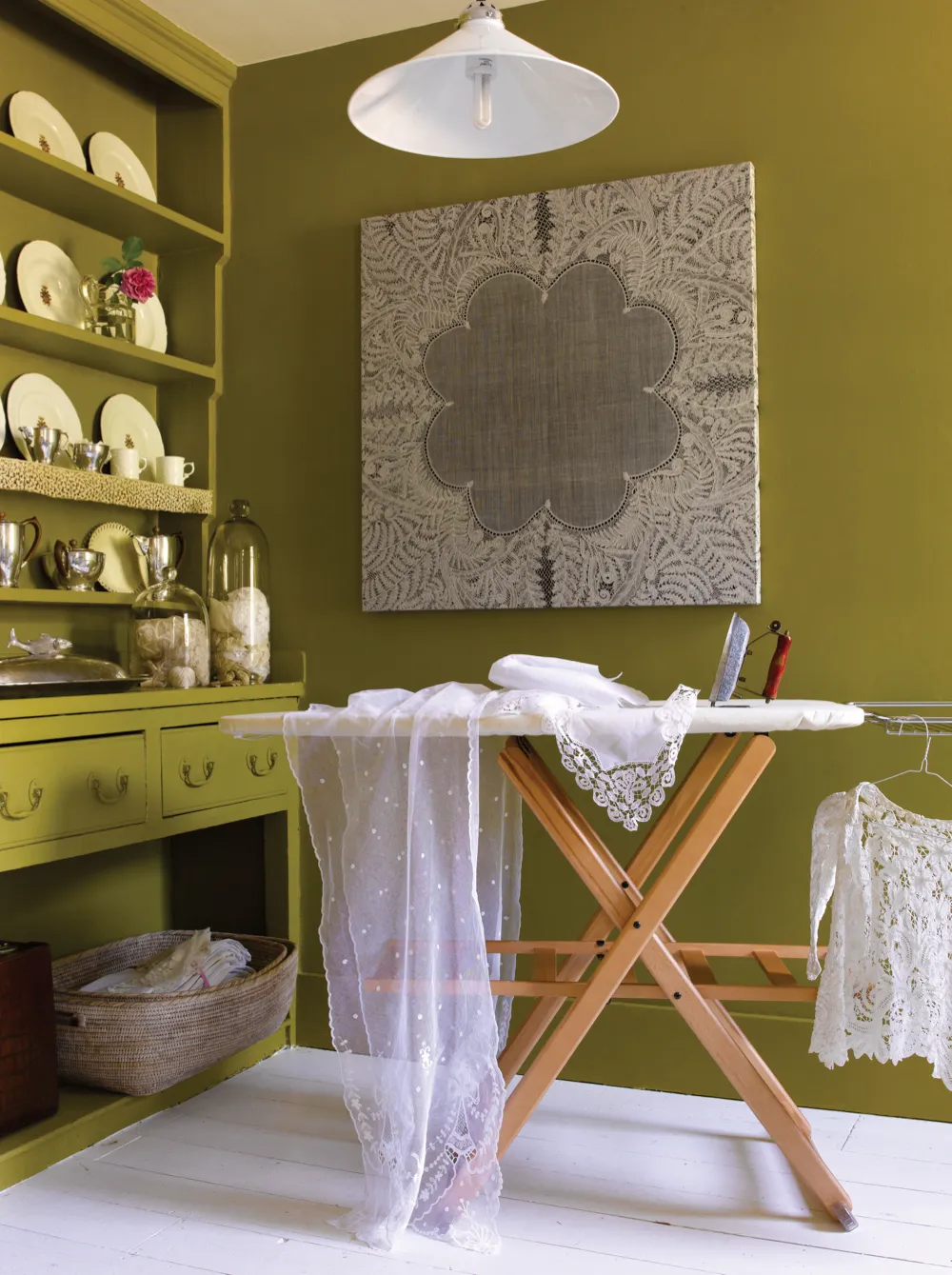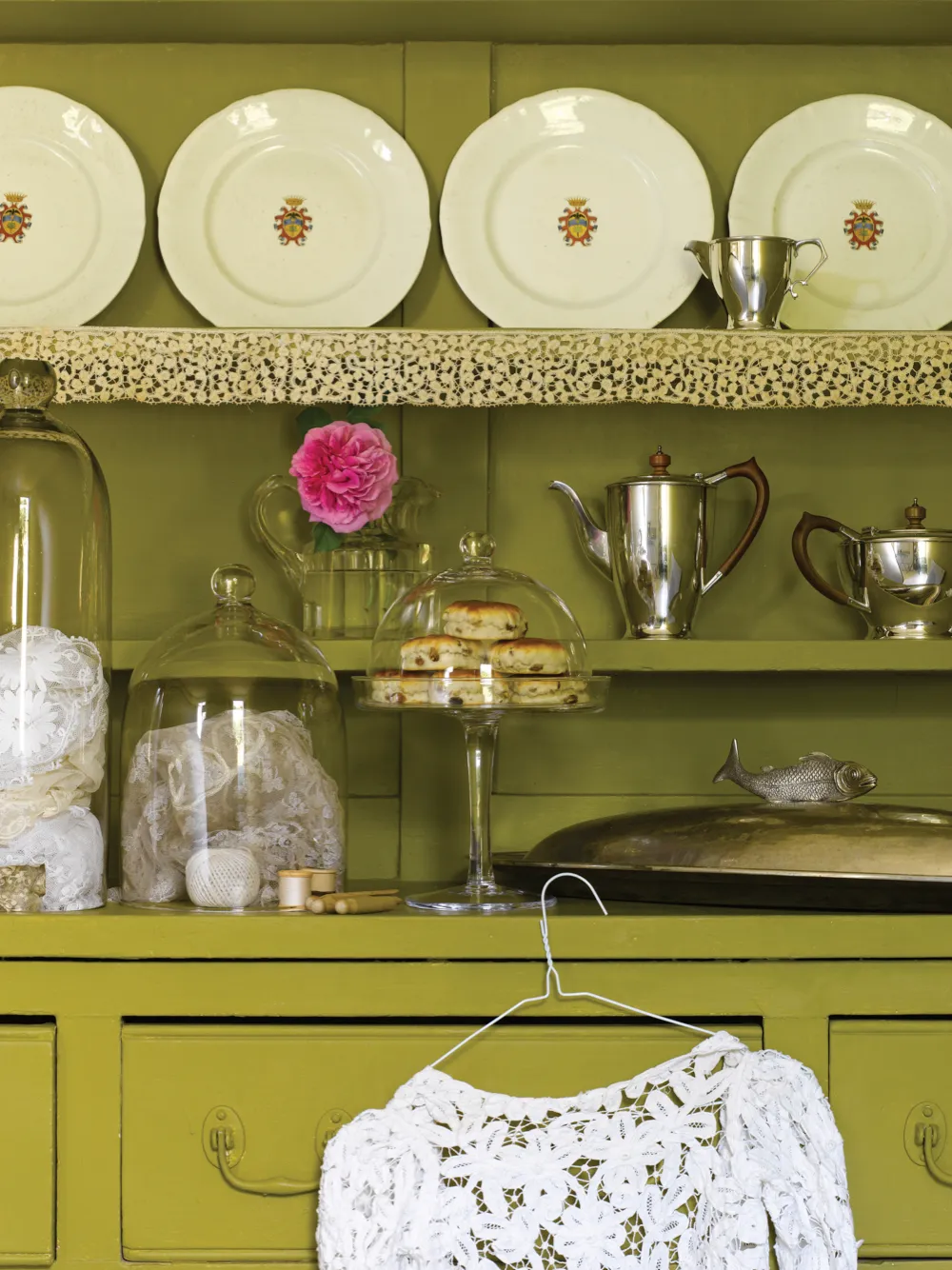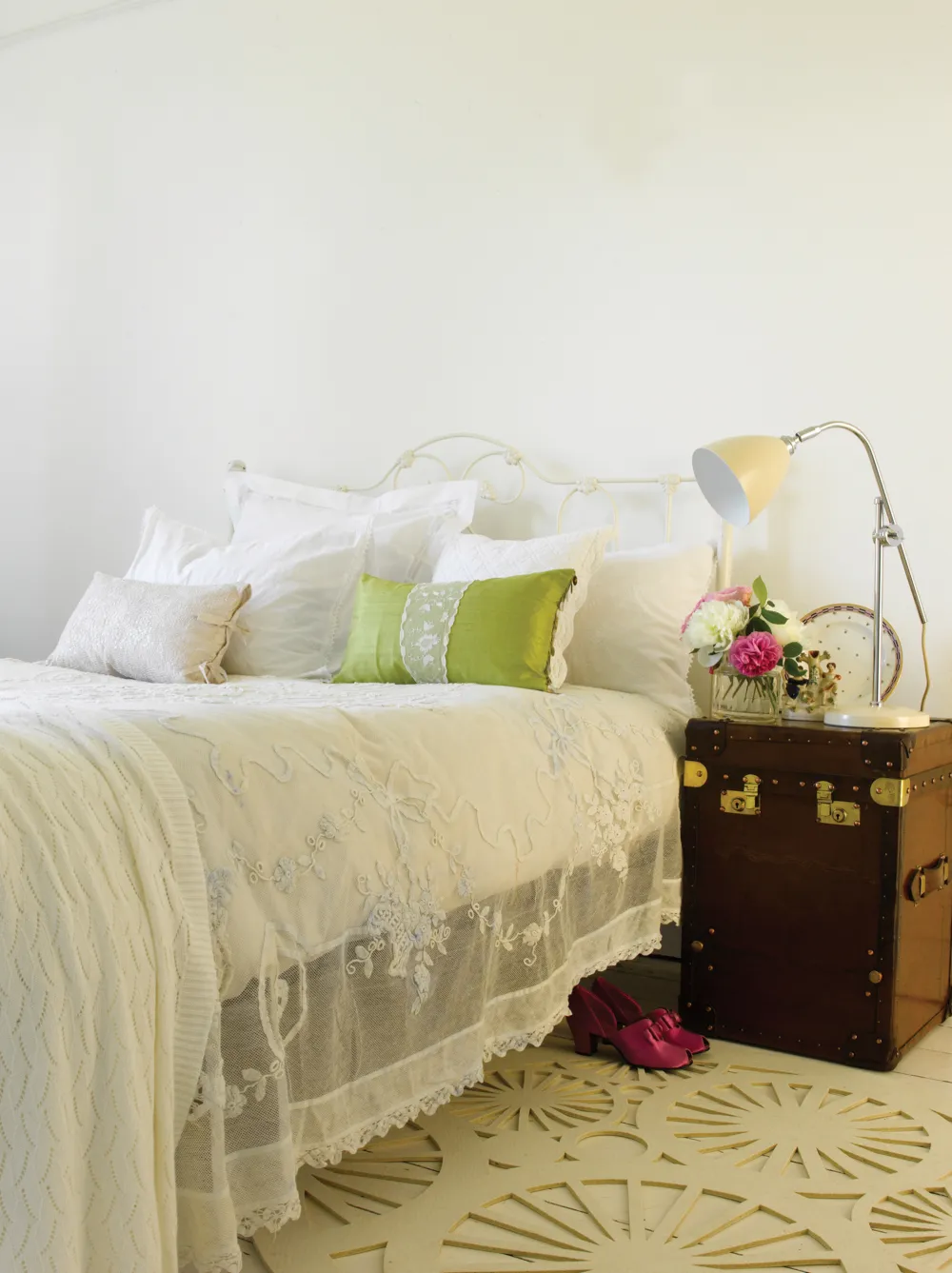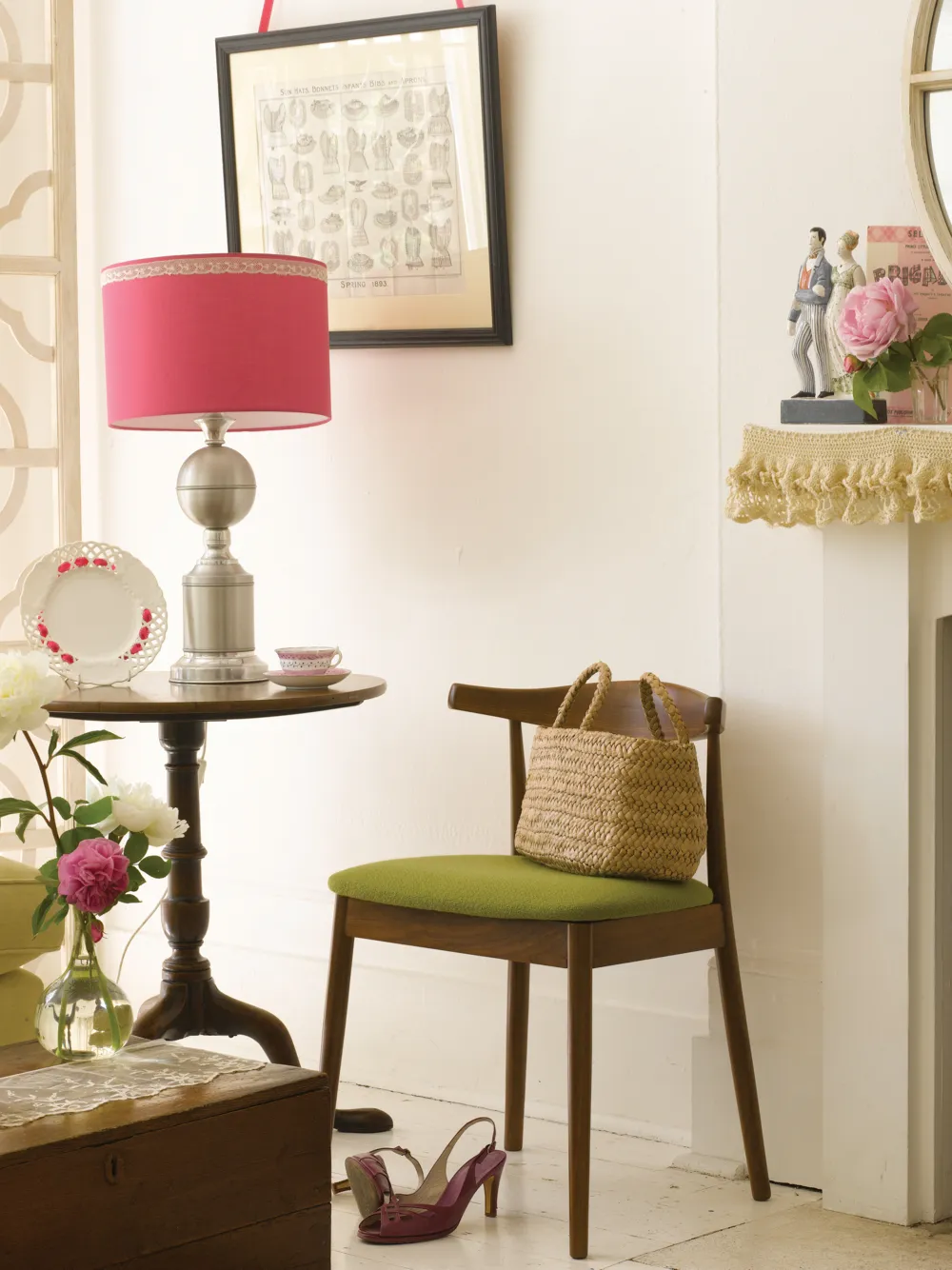To tell the story of lace is to tell the story of society, from the richest of the rich to the poorest of the poor; of revolution and of war; of highly skilled craft and of highly mechanised industry; and of fashion, from wedding veils and noblemen’s ruffs to 21st century high street chic. But why should this fabric hold such particular fascination? Perhaps because its intricacy is almost impossible to believe – some pieces are so fine that only a magnifying glass can reveal their incredible detail. Perhaps because of its sheer variety of forms and styles, encompassing the simplest of repeated patterns to densely worked floral or animal motifs, applied across all sorts of garments and home accessories. Or perhaps because it is such an intrinsic part of our everyday lives – who hasn’t got a lace-edged handkerchief or a pretty doily tucked away in a drawer somewhere?
Lace dealer Diane Harby has her own theory. ‘There is something so emotive about the ethereal quality of lace, its structure, its fragility and its sense of history, that it really moves you,’ she says.
Though lace-like fabrics have been found in ancient Egyptian burial grounds, lace first appeared in a developed form in Italy and Flanders in the early 16th century. The Catholic church, which used it for clerical clothing and church decoration, was among the first customers and lace spread rapidly throughout Europe. By the beginning of the 17th century it had become an essential element in a rich person’s wardrobe – and a profitable industry. Think of the portraits by Anthony van Dyck, in which royalty and nobility are adorned in sumptuous fabric to show off their wealth and status. For the less well-off, lace became a convenient accessory, one that could add a decorative element to an outfit and be moved to other garments as necessary.

On the Continent, lace was made primarily in convents and manufactories; in England, where lace was concentrated in Honiton and the east Midlands, lace-makers worked mainly from home, selling their output to visiting lace dealers. Makers worked to just one or two patterns, often for the whole of their working lives. Lace was also produced in workhouses and so-called ‘schools’ by children as young as six. For middle-class women with little else to do, making lace was a pleasant pastime but, on the whole, it was big business, carried out by the poor, for the rich, with middle men making very comfortable profits. Often they insisted the workers bought their patterns and thread from them and then paid them in tokens that could only be spent in their own shops – thus making money twice over.
First stitches
The first lace-making technique to develop – probably in Italy – was needle lace. This craft involves stitching a pattern to a backing fabric and laying down foundation threads in various motifs.

These are then filled with stitches and, when the piece is finished, the backing is cut off.Bobbin lace, the other main type of handmade lace, probably developed slightly later in Flanders. This is made using many threads (sometimes hundreds), each wound on to a bobbin. A pattern is placed on a ‘pillow’ of straw or, these days, polystyrene, and pins stuck into the pattern. Then the thread is wound around selected pins and the bobbins interlaced and twisted.
Both types of lace were made in huge quantities throughout the 17th and 18th centuries, with designs changing from Renaissance symmetry to rich Baroque, then to the lighter rococo and, by 1800, a sheer, open look. Many styles of lace were named after the place where they were first made, and from this period we find Alençon, point de Venise, Mechline, Brussels, Honiton, Chantilly and more. Before 1800, lace was usually made from linen thread; later, cotton predominated, though other materials such as silk, metal thread, wool and even hair were sometimes used.
The long and glorious era of lace was abruptly ended, in France at least, by the revolution of 1789. Lace meant aristocracy – and aristocracy meant the guillotine. It wasn’t long before the Industrial Revolution began to affect handmade lace production everywhere. English inventor John Heathcoat, who was based near Nottingham, patented his lace-making machine in 1809 and suddenly this once-prized textile became relatively inexpensive. It also fell out of fashion for clothing until the 1840s, when Queen Victoria’s Honiton lace wedding veil started a brief revival. The social changes resulting from World War I were the nail in the coffin and, from the 1920s, the handmade lace industry throughout Europe almost completely died out.
These days, lace is still handmade by enthusiastic craftspeople and in some lace centres around Europe, especially Bruges. The popularity of antique lace, on the other hand, is growing dramatically. While the demand for traditional antique lace bridal veils holds steady, cutting-edge fashion designers are incorporating antique lace into altogether trendier items, from T-shirts to knitwear. Meanwhile, a sense of nostalgia has once again found beautiful old lace table and bed linens a place in the modern home.

Dealers report a growing interest, and not just from the established lace-making areas of Europe, but from Japan and the US too, though prices are still highly affordable. Bonhams has regular textiles sales that include numerous lots of handmade lace. Specialist Eleanor Keene says most lots, which are often a bag full of different pieces that could date from the 17th to the 19th centuries, go for between £200 and £400. Higher and lower prices do often appear: in May 2007, a large Point de Gaze stole sold for £1,260. In the same sale a 19th-century first communion purse in Maltese lace went for £24. ‘Motifs such as animals and figures fetch better prices,’ says Eleanor. ‘Motifs in Honiton lace are highly valued – we sold a collection of them recently for almost £1,000.’
A thing of beauty
Diane Harby, who has a stand at Grays Antiques Market in London, deals in antique lace from 1850 onwards, and sells sets of collars and cuffs for anything from £10 to £100, depending on their complexity. Stephen Lunn, of Lunn Antiques on London’s Portobello Road, deals in lace from as early as the 16th century. A 17th-century Venetian gros point collar could cost £200, he says, or a mid-18th-century pair of French or Belgian lappets, designed to be worn on the back of the head, might be £200 to £800.
‘Eighteenth-century lace was wonderful,’ he explains, ‘though perhaps 19th-century lace has wider appeal. Venetian, Brussels and French lace is really fine, and commands good prices, while English and Irish lace, though still collected, is not considered as good. Very early lace is always in small pieces and doesn’t have much design – it tends to be in repeat patterns and looks quite boring. But people do collect it because of its age, and you could pick up a small piece for a price of about £50.’
Gwynedd Roberts is the honorary curator of the Lace Guild Museum in Stourbridge. While some people collect by period, country of origin, style of lace or type of garment, she says she collects ‘virtually anything – I must have a thousand pieces, ranging in size from two inches long to whole articles of clothing, and from the 17th century to the 21st.’ The appeal of lace, she feels, is down to its combination of beauty and feel.
‘It’s so tactile. One of my particular treasures is some early 17th-century Danish bobbin lace edging, which has an absolutely gorgeous feel, and for sheer beauty I have a very pretty 19th-century Honiton lace veil.’ Gwynedd buys ‘from anywhere and everywhere’ – from village fêtes to antique shops and auctions, in this country and abroad. ‘I always keep my eyes open for a new piece of lace and get tremendous pleasure from my collection,’ she says. ‘If you’re a potential collector, just enjoy lace – it’s absolutely lovely.’

What is lace?
Definitions vary but, essentially, lace is an open fabric made by looping, lacing, twisting or plaiting threads to form patterns. As such, it is slightly different to embroidery, which is stitched on to an already completed fabric, and from open weaves such as gauze. Tatting (which uses a shuttle to make an open pattern), openwork crochet and knitting are related, but not generally regarded as ‘true’ lace. For handmade lace, the two main techniques use a needle or bobbins. Machine-made lace, which originated in Nottingham in the early 19th century, produces an often-excellent imitation of bobbin lace. In chemical lace, another version of machine lace, motifs are embroidered by machine on to a background that is then burnt away with acid.
Buying antique lace
Make sure you know whether what you are buying was made by hand or machine. The latter can still be very beautiful, and up to 200 years old, but should be much cheaper. Stains can be removed with careful hand-washing and minor damage can often be repaired. Lace fades in sunlight so should be kept in acid-free tissue paper in a dim light.
FIND OUT MORE
BUY
LUNN ANTIQUES Unit 8, Admiral Vernon Arcade, Portobello Road, London, 020 7736 4638.
DIANE HARBY Stand 148, Grays Antiques, 58 Davies Street & 1-7 Davies Mews, London, 020 7629 5130.
BONHAMS Station Road, Knowle, 01564 776151. Sale of Costume, Embroideries, Textiles, Lace & Fans on 28th July & 30th November
VIEW
THE LACE GUILD A collection of lace and lace-related items and a comprehensive library. The Hollies, 53 Audnam, Stourbridge, West Midlands, 01384 390739.
THE BOWES MUSEUM One of the world’s largest lace collections. Barnard Castle, County Durham, 01833 690606.
ALLHALLOWS MUSEUM OF LACE AND LOCAL ANTIQUITIES Daily demonstrations of lace-making in July and August. High Street, Honiton, 01404 44966.
READ
GUIDE TO LACE AND LINENS by Elizabeth Kurella (KP Books, 1998)
THE IDENTIFICATION OF LACE by Pat Earnshaw (Shire, 1980, new edition out in October)
FEATURE: Katherine Sorrell
PHOTOGRAPHS: Catherine Gratwicke
STYLING: Charis White